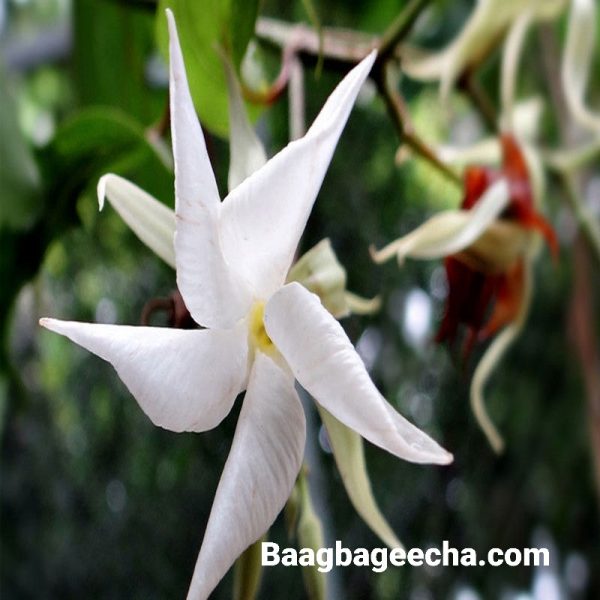How to Grow Jasmine Plants
The combination of fragrant jasmine flowers, vibrant green foliage, and year-round hardiness makes jasmine a worthy candidate for inclusion in your garden. Jasmine includes a wide array of individual species within the genus Jasminum. These unique species feature their own care requirements, but some common rules apply to most.
- 1. Hardiness: Jasmine grows best in warm weather. Nearly all varieties thrive in USDA hardiness zones eight through eleven. Some, like winter jasmine, can withstand the temperature range in USDA zone six, while others, like angel wing jasmine, can only tolerate USDA growing zones nine through eleven.
- 2. Soil: Jasmine does best in well-draining soil with moderate moisture. While many jasmine species are native to humid regions in Asia, they can endure long stretches without rain.
- 3. Sunlight: Jasmine plants can thrive in any degree of light from full sun to partial shade.
- 4. Pruning: Many jasmine species are climbing plants, and they do best when they have a trellis or fence to grow against. Prune your jasmine plant regularly to keep its growth under control. Many species are prone to natural twining, but take care that they do not twine around young tree trunks and stunt their growth.
- 5. Indoor jasmine: Jasmine can make a beautiful and fragrant indoor plant. When grown indoors, jasmine does best in cool air and slightly moist soil. Place your plants in a south-facing window for optimal health. Regularly check the soil for mealybugs, which can damage the plant’s roots, and apply neem oil to deter the pests.
7 Types of Jasmine Plants
Gardeners and landscapers employ different growing techniques for different jasmine species. Explore some of the particularly popular jasmine vines and jasmine shrubs found in gardens throughout the world.
- 1. Common jasmine (Jasminum officinale): Also known as common white jasmine or poet’s jasmine, this plant thrives in both full sun and partial shade. Look for new growth in early spring and flower buds throughout late spring, summer, and fall.
- 2. Pink jasmine (Jasminum polyanthum): This close relative of common jasmine produces both white and pink flowers. It is a natural climber, and its twining vines can exceed twenty-five feet in length.
- 3. Star jasmine (Trachelospermum jasminoides): This plant is known for its phlox-like flowers, which become especially fragrant when grown in direct sunlight.
- 4. Asian star jasmine (Trachelospermum asiaticum): Asian star jasmine offers greater hardiness in cold climates than star jasmine. What’s more, its leaves are smaller and its flowers are more yellow. It can serve as groundcover in both partial shade and direct sunlight.
- 5. Winter jasmine (Jasminum nudiflorum): This shrubby species provides good ground cover and can also be trained to grow up the side of a trellis. Many Victorian homeowners use winter jasmine for landscaping around their houses. True to its name, its bloom time comes in late winter and early spring. It is an evergreen vine and has a year-round growing season in mild climates.
- 6. Arabian jasmine (Jasminum sambac): Despite its common name, Jasminum sambac does not grow natively in Arabia. It is native to southeast Asia and is the national flower of the Philippines. It grows well in warm, humid climates; in colder areas, it can thrive as an indoor plant. Common Arabian jasmine cultivars include ‘Belle of India,’ ‘Maid of Orleans,’ and ‘Grand Duke of Tuscany.’
- 7. Angel wing jasmine (Jasminum nitidum): Also known as shining jasmine, this plant is prized for its large white flowers with delicate petals and purple undersides. It works best as groundcover. Unlike other forms of jasmine, this plant is not hardy and can only grow in USDA zones nine through eleven.
Toxicity and Safety Tips for Jasmine Plants
True jasmines (Jasminus spp.) are non-toxic and safe to handle and prune. Their flowers are even consumed in the form of jasmine tea. However, a similar-looking climbing plant called Gelsemium sempervirens and known by common names like false jasmine, yellow jessamine, and yellow jasmine, is highly toxic. Despite this, the plant has widespread popularity among gardeners and is even the official state flower of South Carolina. Wash your hands after handling Gelsemium sempervirens, and avoid putting any part of the plant in your mouth.







Reviews
There are no reviews yet.